The Google Pixel 3 Review: The Ultimate Camera Test
by Andrei Frumusanu on November 2, 2018 11:00 AM EST- Posted in
- Smartphones
- camera
- Mobile
- Pixel
- Snapdragon 845
- Pixel 3
Display Measurement
The Pixel 3’s screen is an extremely important aspect of the phone, not just because it’s the centre-piece of a device, but also because Google’s choice of panel manufacturer. Last year’s Pixel 2 XL suffered from a compromising display made by LG, which in particular had very large issues regarding gamma as well as black clipping at low brightness levels.
This year, Google opted to swap display suppliers around, with the small Pixel 3 now featuring an LG panel while the bigger Pixel 3 XL uses a Samsung unit. Again unfortunately we don’t have the 3 XL at hand, but we can investigate the Pixel 3’s LG panel and make comparisons on the issue points that plagued last year’s 2 XL.
One thing of note that is a first for Google is the introduction of different display colour modes. This was introduced in Android P / 9 and was backported to last year’s Pixel 2. Google now offers a “Natural” mode which represents accurate sRGB and Display P3 D65 targets, a “Boosted” mode which increases the colour saturations, as well as an “Adaptive” mode which is a bit of a mess but shouldn’t be of any concern to people who don’t care too much about colour accuracy.
As always, we thank X-Rite and SpecraCal, as measurements are performed with an X-Rite i1Pro 2 spectrophotometer, with the exception of black levels which are measured with an i1Display Pro colorimeter. Data is collected and examined using SpectraCal's CalMAN software.
Starting off with the greyscale measurements, I decided to switch over to full scale 256 level measurements to better showcase some of the characteristics of the panels, we’ll get back to this at the end of this page.
In “Natural mode”, the Pixel 3 is very accurate and manages to showcase a DeltaE2000 of 1.36, along with an average colour temperature of 6576K, which is very near the target D65 illuminant.
The phone has a maximum brightness of 407 nits – which is average of an OLED, as recent generation Apple and Samsung devices reach levels above 600nits. Google isn’t employing any auto-brightness boost mode, so sunlight legibility might be less than that of other devices, however I wasn’t able to test this directly in the cloudy weather.
Gamma came in at 2.18 – however looking at the curve it’s notable that for most levels it’s at around 2.3, and the average is brought down by being too bright in the last 5% of levels.
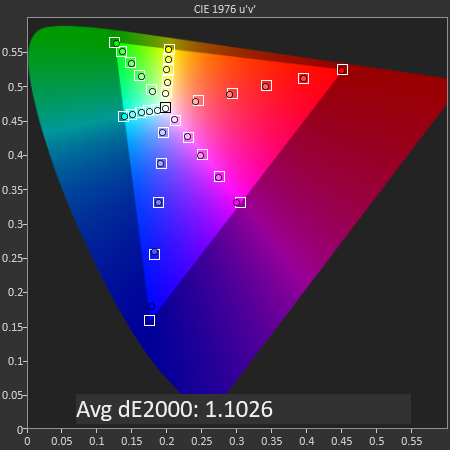
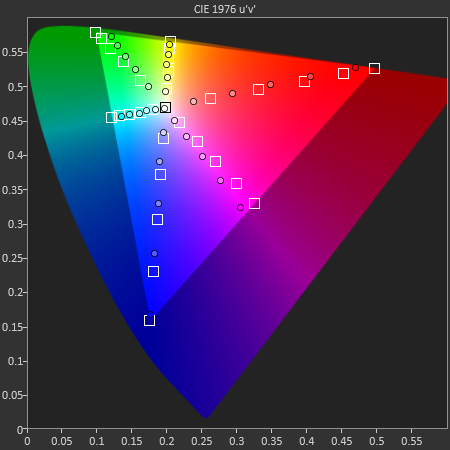 SpectraCal CalMAN
SpectraCal CalMAN
sRGB in "Natural" and in "Boosted" (Against Display P3 Gamut)
When in “Natural” mode, all non-colour managed content targets the sRGB colour-space. Here the Pixel 3’s screen is very accurate with a dE2000 of 1.1, among the best in terms of colour accuracy.
Selecting the “Boosted” mode linearly increases the saturations within the sRGB space – the resulting gamut doesn’t adhere to any standard. The adaptive mode is a complete mess in terms of colour gamut as well as targeting a high gamma of 2.5 – we’ll get back to that into a bit.
Google introduced OS level colour management support in Android 8, however the implementation on the Pixel 2 wasn’t finalised and there wasn’t any application support as of last year. With the Pixel 3 I had hoped that Google would progress on this, however to my great disappointment I didn’t find a single out-of-the box application which would support wide-gamut content.
To demonstrate the issue, you see the Pixel 2, Pixel 3 and an iPhone XS showcasing sRGB and Display P3 images alongside each other in the above photo. By default on Chrome, both sRGB and P3 images are equal, while the XS correctly showcases the higher saturation of the full-level red of the P3 image.
There is one way to bypass this issue, and that is to explicitly tell Chrome to override the default provided system colour profile and just tell it the display is Display P3. This enables colour management in the app, and short of writing a custom application, is the only way to get wide colour gamut content to work on the Pixel 3.
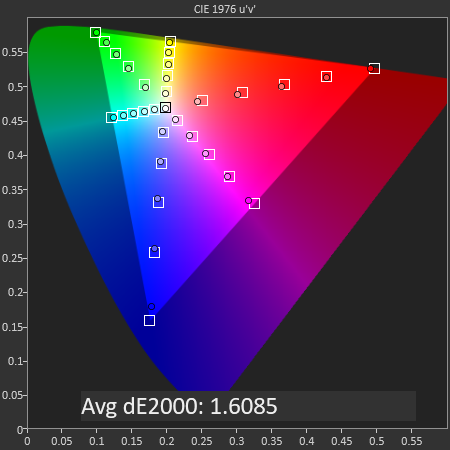
 SpectraCal CalMAN
SpectraCal CalMAN
Display P3 in "Natural" and in "Boosted"
Now one of the big questions I’ve had this year is how the CMS would interact with the actual display colour profiles in the settings. Fortunately, it’s pretty straightforward: The “Natural” mode isn’t per se a colour gamut selection, is just an actual category which has both accurate sRGB and P3 display modes via the CMS.
Testing out the Display P3 targets, the Pixel 3 showcases a good dE2000 result of 1.6. The display didn’t score better because seemingly the blue spectrum isn’t fully hitting the target saturations, something that also happened in the sRGB targets. Testing the P3 targets in the “Boosted” mode, we see again what is happening is that this mode just linearly increases the saturations. The blues are nearer to the P3 targets but all other colours overshoot the P3 target now.

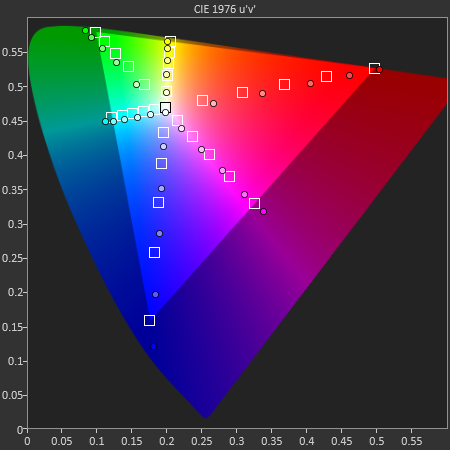 SpectraCal CalMAN
SpectraCal CalMAN
sRGB and Display P3 Targets in "Adaptive"
Now the fun thing is testing what happens with the sRGB and Display P3 images when you’re in “Adaptive” mode. sRGB obviously is quite a disaster – I didn’t manage to match this resulting gamut to any existing standard so there’s no real point in measuring an error rate. Now what is really interesting is to see the CMS expand the resulting visible gamut with the P3 images – here we’re seeing something that is far wider than Display P3, especially in the blues. Again this doesn’t really match any standard gamut, so there’s no point in making direct comparisons.

SpectraCal CalMAN
GretagMacBeth in "Natural"
The GretagMacBeth colour test in natural mode results in accurate colours with a dE2000 of 1.28.
Gamma curves under magnifying glass
One of the reasons I want to switch to full 256 level greyscale testing is to better show case the luminance behaviour, specifically highlighting the issue of “black clipping”.
The Pixel 2 XL, along with the LG V30, suffered very badly from black clipping at low brightness levels. I generally attribute this to the fact that those generation panels just used the DDIC’s ADC bit-depth for both colour representation as well as brightness control. Samsung OLEDs use PWM on top to control brightness by just adjusting the duty level – with voltage of the pixels determining the colour intensity. The Pixel 2 XL and V30 seemed to lack sufficient range to cover the level-spectrum at the low-end, and this resulted in notorious black clipping.
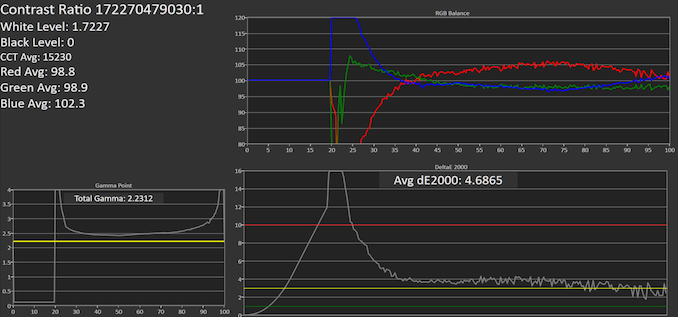
SpectraCal CalMAN
Pixel 2 XL
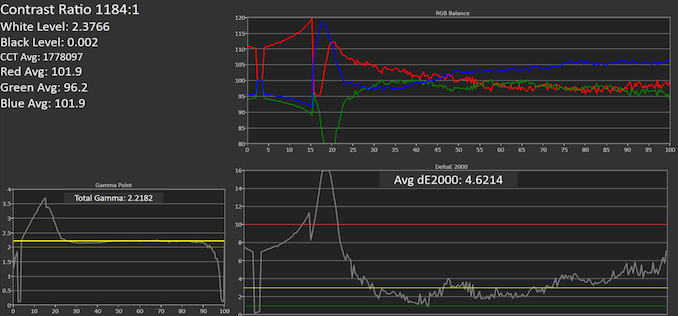 SpectraCal CalMAN
SpectraCal CalMAN
Pixel 3
At minimum brightness, the Pixel 3 improves over the Pixel 2 XL in this regard, but it’s still pretty terrible as it’s clipping 15% of levels to black, as opposed to 25% of the Pixel 2 XL.
The higher the brightness, the less pronounced the issue is. At 200 nits compared across the Pixel 3, Pixel 2 XL, S9+ and an iPhone XS, we see that all of the Android phones are clipping the first few greyscale levels to black, with Apple being the only manufacturer able to perform excellently in this regard.
Also one thing that becomes evident when doing full-scale 256 level measurements is the fact that the Pixel 3 colour balance across levels is very haphazard, and we see quite a zig-zagging behaviour between the intensities at different levels, also represented by the dE2000 results. In absolute terms, this shouldn’t be an issue as overall the error rate is acceptable, however it’s a stark behavioural contrast to any other phone I’ve measured before.
Overall, the Pixel 3’s screen is an improvement over the Pixel 2 XL, however it doesn’t fully solve the low-brightness issues that are plaguing LG’s OLED panels, and Samsung panels such as on the Pixel 2 are still better this this regard.
In terms of colour accuracy, the Pixel 3 performs well. Here I would have hoped that Google would have gotten wide colour gamut support fully working within its applications – currently the only way to get this to work is to change a Chrome settings flag, and this only solves the problem for Chrome, and no other app.
Lastly, the display brightness is good, however again it’s just adequate at up to 400 nits, and fails to compete with super bright displays from competing flagships.


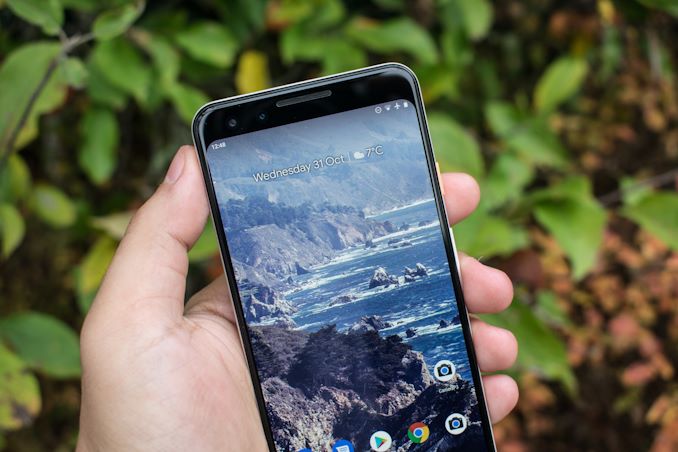
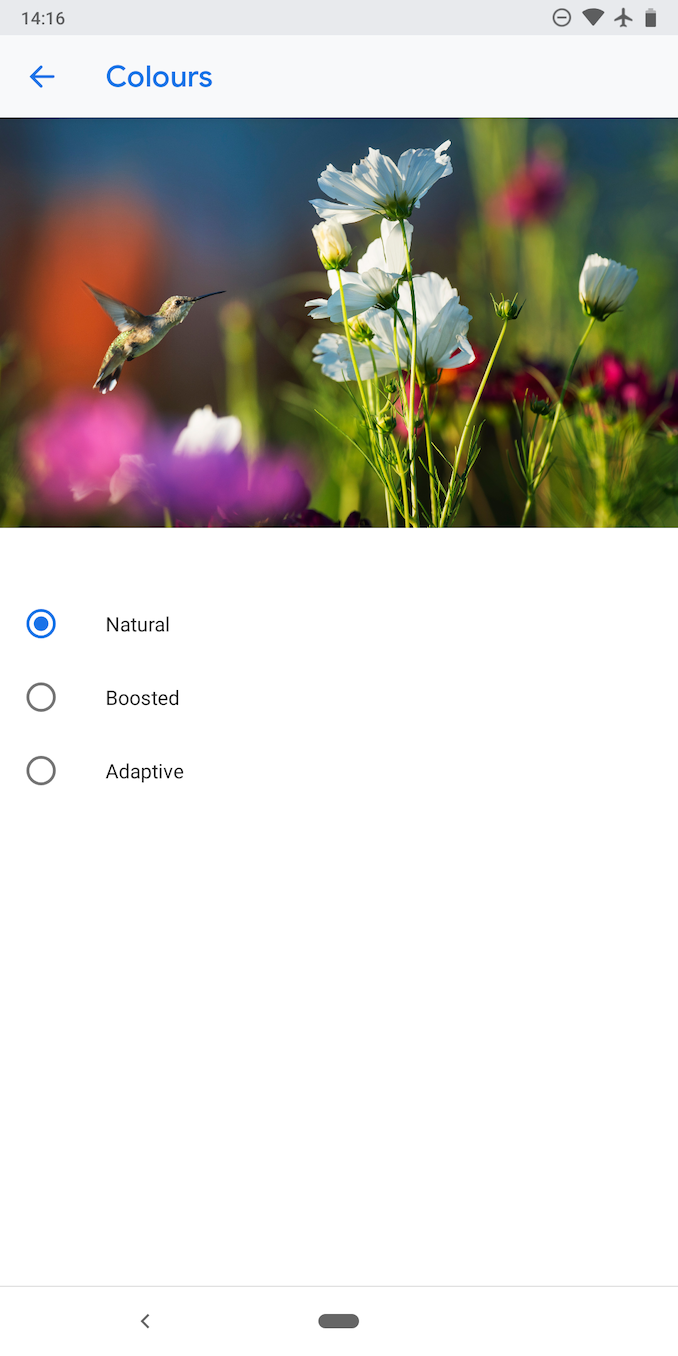
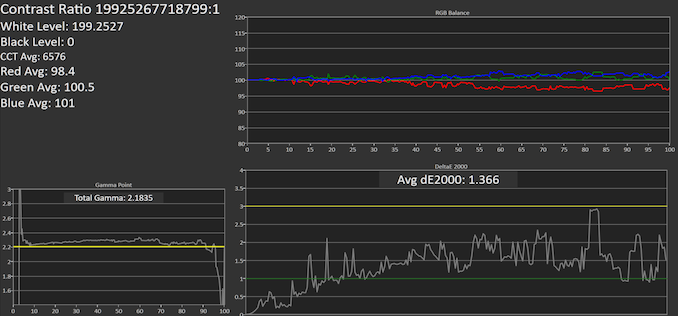

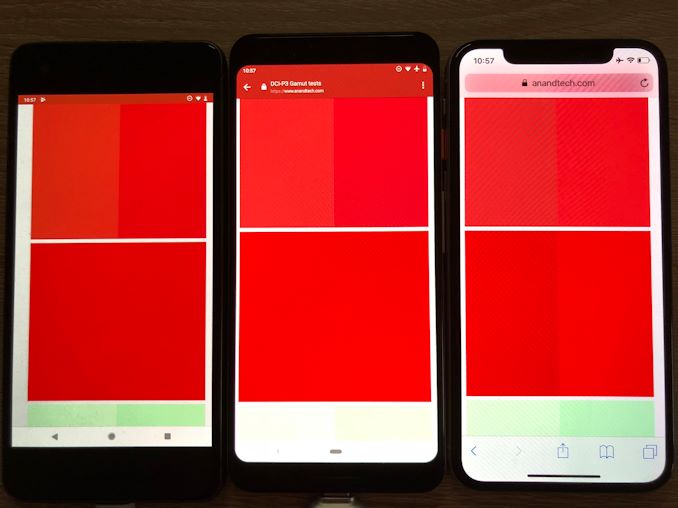
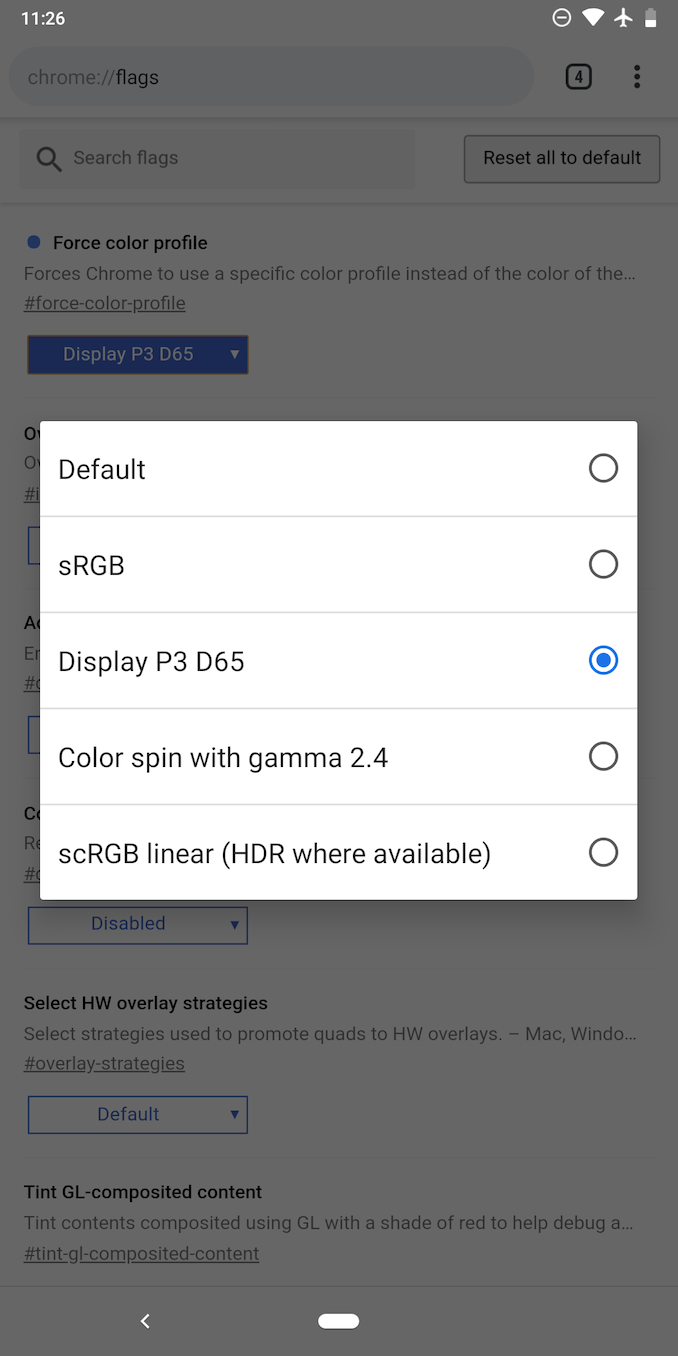









135 Comments
View All Comments
Impulses - Saturday, November 3, 2018 - link
Bluetooth audio bandwidth has actually not increased since BT2.1+EDR AFAIK (half a decade ago), a lot of vendors trip over themselves to boast about the BT spec supported by the chip in their products but that's just all it is... The A2DP profile hasn't seen major changes and most of the bandwidth improvements in latter BT spec revisions were for BT LE and wearable devices that started off at a much lower floor (than A2DP over 2.1+EDR).The provisions for better 3rd party codecs like Sony's LDAC were even present in the BT spec all the way back then, that wasn't added in recent revisions, tho the codecs themselves have gotten better and now represent a decent improvement over stock SBC. I'm not knocking BT mind you, I think overall it's better implemented these days so there *has* been improvement in the user experience and SQ even if it's not due to spec revisions (and it's not).
I'm still not in favor of dropping the jack myself, but it's not a deal breaker for me. I use a BT adapter most of the time if I'm on the go (EarStudio ES100 right now) and have the dongle as a backup if that's out of battery. I have a pretty decent home setup tho and BT would absolutely be a bottleneck there, it still hasn't become totally transparent or enough for lossless the way the stereo BT profile is laid out AFAIK.
melgross - Sunday, November 4, 2018 - link
I can’t stand wired headphones for mobile devices. They’re more than annoying.serjrps - Friday, November 2, 2018 - link
Any plan to include the latest OnePlus camera updates in the review, maybe along with a OnePlus 6T review?HunterAMG - Friday, November 2, 2018 - link
Ah yes, the only review that matters.The only thing I disagree with, though, is with the quality of the included ear buds. They are not great for sure, but in my experience they are okay, and they match or surpass the apple ear pods' quality, which I was using before. I'm curious if you just happened to get a defective unit.
Andrei Frumusanu - Friday, November 2, 2018 - link
The Apple headphones are significantly better. I'll follow up with actual frequency response measurements of both.Andrei Frumusanu - Saturday, November 3, 2018 - link
Here's a very quick follow-up: https://twitter.com/andreif7/status/10586681768783...Rmrx8 - Saturday, November 3, 2018 - link
What's interesting to me is you now have ultra expensive phones that test your hearing and make a sound profile. Changing EQ to fit your profile and maximize your enjoyment of the music. Why would that be a thing if everyone heard all frequencies equally like a measuring device? You don't like them. That's fine. I like them and grab them more often than Apple's. I'll be the first to admit I'm older and my hearing is probably different from when I was a teenager. At the end of the day, it IS subjective for different people based upon age, ear shape, etc.Andrei Frumusanu - Monday, November 5, 2018 - link
> What's interesting to me is you now have ultra expensive phones that test your hearing and make a sound profile. Changing EQ to fit your profile and maximize your enjoyment of the music.The Pixels have no such option, the sound you get out of the box is what you're stuck with.
Rmrx8 - Saturday, November 3, 2018 - link
How old are you Andrei? It'll affect your subjective listening evaluations. I have no doubt google's buds will be inferior when scoped for frequencies. But a difference you can't hear is no difference. I find these less harsh in high frequencies than Apple EarPods, which I have used daily for over a year. I disagree strongly that Apples are "significantly better". They fall out of the ears too easily, and the earbud mic is too aggressive at staying off to avoid background noise. Then it cuts in and misses the first consonant of speaking. The Google mic stays "on" more and this the recorded sound is more even with less blasts of ambient hiss.Andrei Frumusanu - Monday, November 5, 2018 - link
> But a difference you can't hear is no difference.Let me be clear here, I did the FR after-the-fact of simply listening to them and comparing them to the buds from all other vendors. There's no point in arguing about subjective evaluation validity when comparing subjectively between units.